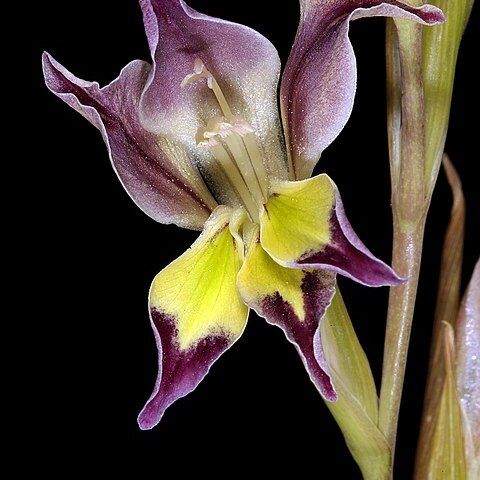Plants (120-)200-350 mm high. Corm globose-conic, 12-15 mm diam., with small cormlets at base; tunics ± woody, fragmenting irregularly and often claw-like below, orange when young. Stem erect or inclined, flexed outward above sheaths of upper leaves, simple or often 1-or 2-branched. Leaves (5)6 to 8, lower 4 to 6 basal and usually in a 2-ranked fan, grey-green, often glaucous, reaching to base or sometimes middle of spike, narrowly lanceolate to linear, (2-)3-5 mm wide, fairly thick and succulent, main vein lightly raised, margins not raised, uppermost cauline leaf diverging from stem or sheathing only near base. Spike inclined, lightly flexuose, 5-to 8-flowered; bracts pale green, translucent on veins, occasionally dry near tips, outer 20-30(-35) mm long, inner shorter, acute or minutely forked. Flowers greenish cream-coloured to yellow-brown or beige, upper tepals sometimes flushed purple above, lower tepal limbs yellow basally and brown to purplish above, throat irregularly streaked with purple, strongly sweet-scented; perianth tube obliquely and narrowly funnel-shaped, 12-14 mm long, slender lower part 8-9 mm long; tepals lanceolate, dorsal largest, inclined over stamens, 25-35(-42) x 10-14(-16) mm, upper laterals arching outward, 22-28(-35) x 9-15 mm, windowed between dorsal and upper lateral tepals, lower 3 tepals united with upper laterals for 3-4 mm and together for 4-7 mm, narrowed into claws below, claws narrowly channelled, 4-6 mm long, limbs abruptly expanded and deflexed, sometimes with weakly developed auricles, 10-15(-20) x 8-12 mm. Filaments 12-16 mm long, exserted 9-12 mm from tube; anthers 6-9 mm long, light purple to cream-coloured; pollen cream-coloured. Style arching over stamens, dividing opposite or just below anther apices, branches 3.0-4.5 mm long. Capsules obovoid, trilobed-retuse above, 9-14 mm long. Seeds 5-6 x ± 5 mm, broadly and usually asymmetrically winged with seed body closer to one side.
More
Cormous geophyte, 200-600 mm tall, corm with gnarled woody tunics. Leaves sword-shaped to falcate, plane. Flowers 5-8 in a flexuose, inclined spike, bilabiate, brown to yellowish, lower tepals banded yellow and purple, windowed in profile, sweetly scented, dorsal tepal arching, lower tepals pinched together below.

